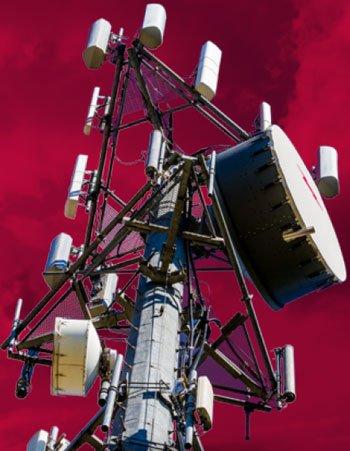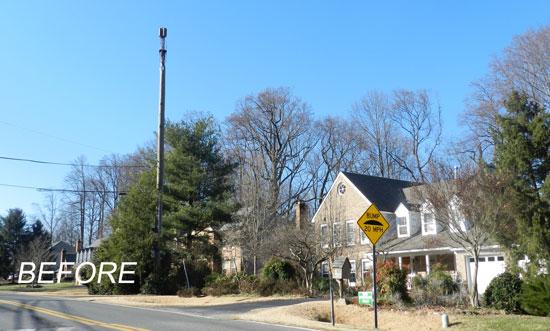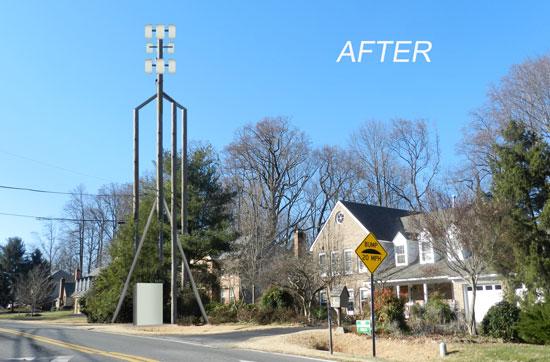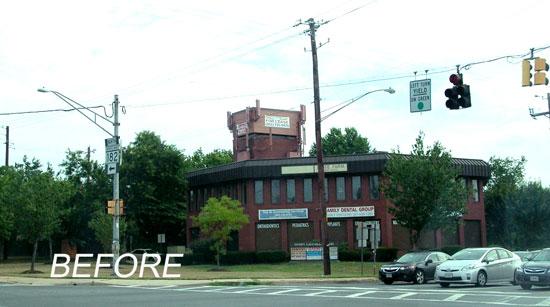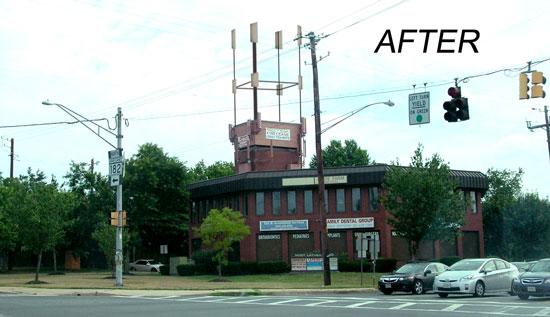Wireless Industry Seeks to Limit Local Zoning Authority
Gail A. Karish is an attorney with the law firm of Best Best & Krieger LLP. She can be reached at Gail.Karish@bbklaw.com.
The wireless industry in the United States provides mobile telephone and data services (Internet and/or broadband access) and leads the world in network investment.1 Yet industry lobbyists continue to advocate before Congress, state legislators and the Federal Communications Commission (FCC) that a barrier to upgrading and expanding the industry’s wireless infrastructure exists and must be cleared away — and that barrier is local zoning requirements.
As Western City goes to press, the FCC is considering rules to implement federal legislation designed to limit local authority over the siting of wireless facilities, such as placing new antennas and equipment on existing sites and towers or otherwise modifying or expanding existing wireless facilities.2 If the FCC adopts the proposed version of these rules, generally referred to as the “proposed rules,” the wireless industry will gain more authority to demand or influence local changes to the visual character of communities throughout California and the nation. The proposed rules may also allow for:
- Potentially unsafe installations of the new antennas and equipment on existing sites and towers; and
- Other modifications or expansions to existing wireless facilities.
This article provides background on the sources of applicable law and current wireless issues at the federal, state and local government levels. It also explains why whenever changes are proposed it is important for local officials to express their views about how to improve the rules to preserve and protect local authority and discretion over issues of public safety and aesthetics related to wireless facility siting and maintenance in California cities.
Background
Cities must comply with various federal laws, FCC regulations and orders, California statutes and their own local ordinances as they consider the private installation and maintenance of wireless antennas and equipment on existing sites and towers. In 2012 Congress adopted the Middle Class Tax Relief and Job Creation Act,3 a statute best known for extending tax cuts and unemployment benefits. Buried in the law is Section 6409(a), which requires local government approval of certain wireless facilities installations even if local zoning laws or policies would otherwise preclude or limit their particular placement or location. Section 6409(a) is the first federal law passed in nearly two decades that directly affects a city’s zoning authority over wireless facilities. Some would argue that Section 6409(a) was added to the tax relief and job creation statute as a result of successful lobbying by the wireless industry. The FCC’s proposed rules will implement Section 6409(a) and apply to local jurisdictions throughout the nation — including all California cities.
A key question for the FCC in developing the proposed rules has been what types of facilities must be approved under Section 6409(a).4 The statute provides that “notwithstanding … any other provision of law, a state or local government may not deny, and shall approve, any eligible facilities request for a modification of an existing wireless tower or base station that does not substantially change the physical dimensions of such tower or base station.” An “eligible facilities request” is any request to modify an existing wireless tower or base station that involves collocating, removing or replacing transmission equipment. Although the formal comment period has ended, the FCC will accept input on the proposed rules until it issues the final rules and regulations. It is therefore not too late to voice concerns, and city officials have many reasons to participate in the rule-making process.
For example, the proposed rules as currently written would require cities to approve a 20-foot extension to any existing wireless facility — even if the modification makes a camouflaged facility plainly visible or adversely impacts a historical preservation district or an environmentally sensitive area. The extension may even unnecessarily intrude upon a residential neighborhood and negatively impact property values or alter an existing, non-conforming structure. The proposed rules do not even explicitly preserve local authority to protect people or property against unsafe installations. (See below. Photos courtesy of Engineering Analysis of Technical Issues Raised in the FCC’s Proceeding on Wireless Facilities Siting report, prepared by CTC Technology & Energy, and submitted as an exhibit to comments to the Federal Communications Commission made by a nationwide coalition of cities.)
Participating in the FCC’s rule-making process is important for another reason — it can impact the outcome. Although the wireless industry may have succeeded in its recent lobbying efforts in Congress, it has also suffered defeats when local interests have made a strong showing to share their perspective and concerns.
For instance, in 2011 the FCC considered how to remove “barriers” to broadband deployment.5 The wireless industry pointed to local governments as a major barrier and included long lists of allegedly troublesome jurisdictions in agency filings. National associations representing local authorities and many individual cities and counties countered with an effective response. Ultimately no rules or further proceedings were adopted. Instead, the FCC convened an educational workshop on distributed antenna systems and small cell technologies. In 2009, responding to an industry petition seeking clarification of an existing federal statute,6 the FCC adopted what’s commonly known as the “shot clock order,” which established a nationwide standard for the “reasonable period of time” for a city or county to process wireless applications.7 Local government opposition did not stop that order but it did help persuade the FCC to include requirements less draconian than the industry had advocated.8
Similarly, in California during 2013 state legislation was introduced that would have put severe limits on city authority to regulate the placement of wireless facilities.9 A prompt and vigorous response by the League and its member cities, as well as other local government organizations, helped stop the legislation from passing — although it may be reintroduced this year.10
Rules Adopted in 1996 Already Serve Industry And Cities Well
Tensions between national infrastructure policy goals and local zoning control are common. How to balance the two is not a new debate. Where deployment of wireless facilities is concerned, the balance has usually tipped toward retaining local control and authority for cities. Congress considered seriously limiting local zoning authority in 1996 but after intense debate and heavy participation by cities, the Telecommunications Act enacted that year generally preserved local authority over wireless facilities siting.11 Section 332(c)(7) of that statute preserves local zoning authority over “the placement, construction and modification of personal wireless service facilities,” but also subjects the authority to certain limitations.12
The wireless industry has prospered under the Section 332(c)(7) requirements that respect local zoning discretion. The industry has grown exponentially since 1996. It has made more than $330 billion in cumulative wireless infrastructure investment and is projected to invest another $34 to $36 billion per year over the next five years.13 Between 1996 and 2012 the number of cell tower sites increased tenfold, from about 30,000 to more than 301,000.14
So why are new rules necessary? Common refrains claim that cities and counties are slow to act on requests for collocations and minor modifications to existing wireless facilities, and that this affects deployment of facilities needed for wireless broadband service and could slow the rollout of a nationwide public safety network. But collocations and minor modifications are typically favored by cities over new sites, and cities would be very unlikely to needlessly hold up deployment of improved public safety networks. Thus, the rationale for new rules is unclear.
Section 6409 and the Proposed Rule-Making
Section 6409(a) differs from the 1996 law because it mandates local government approvals, but it is unclear what exactly must be approved. Last year, the FCC’s Wireless Bureau issued nonbinding “interpretative guidance” on Section 6409(a) that was considered favorable to the industry.15 The guidance raised many aesthetic, historical preservation, environmental and public safety concerns for local governments. As the FCC now considers the proposed rules based on that guidance, it has raised dozens of questions about the role of cities in responding to applications for siting or collocating new wireless facilities, including new antennas and equipment.16
These questions include:
- Should the FCC even make rules, or would there be benefits to giving cities and counties the first opportunity to implement Section 6409(a) without any federal rules?17
- How should key terms in the statute be defined? For example, should an existing wireless tower mean a structure built and used solely or primarily for wireless facilities (the classic wireless tower), or should it include any structure that might be used for wireless facilities such as a streetlight, utility pole, building or water tank — whether or not it currently hosts any wireless facilities?18
- What is a “substantial change” in the physical dimensions of a tower? This is a critical threshold in the statute, because under the proposed rules cities must approve a proposed tower modification that does not result in a substantial change. The proposed rules were based on a test adopted when the FCC implemented a different federal statute.19 Taking that approach here could, for instance, require city approval of a 20-foot extension to any existing wireless facility — including a streetlight or utility pole.
- Should the FCC impose limits on application requirements, fees or processes?20
- Should the FCC deem an application “granted” if a city does not act within a specified period or would this remedy violate the U.S. Constitution?21
- Does the statute apply to local governments acting in their capacity as property owners?22
In addition to the questions related to wireless facility siting, the FCC’s rule-making contemplates whether further rules are needed to implement the FCC’s shot clock order.23 For example, the FCC asks what has been cities’ and the industry’s experience operating under the shot clock order and whether additional remedies are needed, such as deeming an application granted if a city hasn’t acted on it before the shot clock deadline expires. The FCC’s extensive questions suggest that its final rules could be more reasonable than its current proposals. But this won’t happen if the agency hears only from the wireless industry as it considers adoption of the final version of the rules. The FCC needs to be educated by city officials who deal with wireless facilities siting on a daily basis.
Conclusion
Wireless facilities siting raises political and legal issues that are becoming ever more complex. Cities already must comply with various federal laws, FCC regulations and orders, state statutes and their own local ordinances when wireless providers come before them for approvals to place new antennas and equipment on existing sites or otherwise modify or expand existing wireless facilities. Cities also often face public opposition to the wireless facilities and threats of litigation from wireless providers. All of these factors can impact the approval process and the proposed deployment. The proposed rules threaten to curtail or at least reduce city authority or discretion over wireless siting.
Effective defense of cities’ interests in the FCC’s rule-making requires a significant effort. The League (together with the California State Association of Counties and the California and Nevada Chapter of the National Association of Telecommunications Officers and Advisors) has already filed helpful comments on the proposed rules. (See the joint comments on the League web page devoted to federal issues at www.cacities.org/Policy-Advocacy/Federal-Priorities-and-Issues.) Although the formal filing deadlines have passed, it is not too late for city officials to write a letter and/or set up a meeting with FCC commissioners or staff to express their concerns about this potential federal intrusion on local land-use decisions — and seek to protect and preserve local authority over public safety and aesthetics in the community.
Footnotes:
[1] See “THE U.S. WIRELESS INDUSTRY: Leading the World in Investment, Value, Innovation, and Competition,” (November 2013), a report attached to an ex parte letter dated November 13, 2013 filed by CTIA – The Wireless Association to welcome new appointees to the Federal Communications Commission, Chairman Wheeler and Commissioner O’Reilly, available at http://files.ctia.org/pdf/filings/2013_CTIA_Investment_and_Innovation_Letter.pdf.
[2] In re Acceleration of Broadband Deployment by Improving Wireless Facilities Siting Policies, WT Docket No. 13-238, FCC 13-122 (9/26/2013), available at http://apps.fcc.gov/ecfs/document/view?id=7520945675.
[3] Pub.L. 112–96, H.R. 3630, 126 Stat. 156, enacted Feb 22, 2012.
[4] 47 U.S.C. § 1455(a).
[5] Acceleration of Broadband Deployment: Expanding the Reach and Reducing the Cost of Broadband Deployment by Improving Policies Regarding Public Rights of Way and Wireless Facilities Siting, Notice of Inquiry, 26 FCC Rcd 5384 (2011).
[6] 47 USC § 332(c)(7).
[7] The FCC established two time periods: 90 days for action upon a collocation request; and 150 days for action upon a new siting application. California jurisdictions are already subject to state or local rules that establish time limits for actions such as the Permit Streamlining Act. The “shot clock” applies “independent of the operation” of the local rules.
[8] Local governments also challenged whether the FCC had the authority to make such an order but the FCC authority was upheld by the U.S. Supreme Court. City of Arlington v. FCC, 133 S. Ct. 997 (2013).
[9] Under the proposed bill:
- A request for a modification of an existing wireless telecommunications facility that does not substantially change the physical dimensions of the facility must be approved.
- Eligible requests are broadly defined to include installations in the rights of way (on utility poles, for example) as well as sites outside the rights of way (a typical macro cell site).
- “Substantially change” is defined in a manner that could mandate local approval of very significant modifications to existing facilities. For example, a local authority could be compelled to allow a previously approved distributed antenna system (DAS) running down Main Street to place additional appurtenances “that would protrude from the edge of” the existing facilities for 20 feet in any direction.
- Unless an eligible application is deemed incomplete, it would be “deemed approved” if not acted upon within 45 days.
- Local authorities would not be able to consider whether the requested facilities are needed to fill in a gap in service coverage.
[10] Officially the bill was “dead” as of Jan. 20, 2014, because that was the last day for any committee to hear and report to the floor on the bill per Rule 61(b)(2) of the Legislative Rules. However, the Legislature does have the ability to ‘waive’ a rule and if this is done then AB 162 can continue. Similar language can also be added to another bill in what is known as “gut & amend.”
[11] 47 U.S.C. § 332(c)(7).
[12] These limitations are:
- Regulations shall not unreasonably discriminate among providers of functionally equivalent services.
- Regulations shall not prohibit or have the effect of prohibiting the provision of personal wireless services.
- Requests for authorization must be acted on within a reasonable period of time after the request is filed, taking into account the nature and scope of such request.
- Decisions to deny a request shall be in writing and supported by substantial evidence contained in a written record.
- Regulation may not be based on the environmental effects of radio frequency (RF) emissions to the extent that such facilities comply with the FCC’s regulations.
[13] For historical investment data see “CTIA’s Semi-Annual Wireless Industry Survey Results, December 1985 – December 2012,” available at http://files.ctia.org/pdf/CTIA_Survey_YE_2012_ Graphics-FINAL.pdf. For projections see Dr. Alan Pearce, et al., Wireless Broadband Infrastructure: A Catalyst for GDP and Job Growth 2013-2017 (2013), available at http://www.pcia.com/images/IAE_Infrastructure_and_Economy.pdf.
[14] Id.
[15] “Wireless Telecommunications Bureau Offers Guidance On Interpretation Of Section 6409(A) Of The Middle Class Tax Relief And Job Creation Act Of 2012,” DA 12-2047, January 25, 2013, available at ftp://ftp.fcc.gov/pub/Daily_Releases/Daily_Business/2013/db0128/DA-12-2047A1.pdf
[16] Sections IV and V of the notice address local zoning authority. The notice’s first two sections do not directly target local zoning authority. They are relevant to a local government to the extent that the community does not impose its own environmental or historical-preservation requirements or regulate the placement of temporary towers, but instead relies on the FCC’s processes and restrictions. Section II concerns whether the FCC should expedite its National Environmental Policy Act and National Historical Preservation review processes for DAS and small cells, including by categorically excluding these deployments from review. NPRM ¶¶ 36-67. Section III proposes to exempt from the Commission’s antenna-structure-registration-notification requirements certain temporary antenna structures. Specifically, the FCC proposes to exempt an antenna structure if it: (i) will be in use for 60 days or less; (ii) requires notice of construction to the FCC; (iii) does not require marking or lighting pursuant to FAA regulations; (iv) will be less than 200 feet in height; and (v) will involve minimal or no excavation. NPRM ¶ ¶ 78-89.
[17] NPRM ¶¶ 95-100.
[18] NPRM ¶ 108.
[19] NPRM ¶ 118.
[20] NPRM ¶ 131-134.
[21] NPRM ¶ 137.
[22] NPRM ¶ 129.
[23] NPRM ¶¶ 144-162.
About Legal Notes
This column is provided as general information and not as legal advice. The law is constantly evolving, and attorneys can and do disagree about what the law requires. Local agencies interested in determining how the law applies in a particular situation should consult their local agency attorneys.
This article appears in the April 2014 issue of
Western City
Did you like what you read here? Subscribe to Western City

